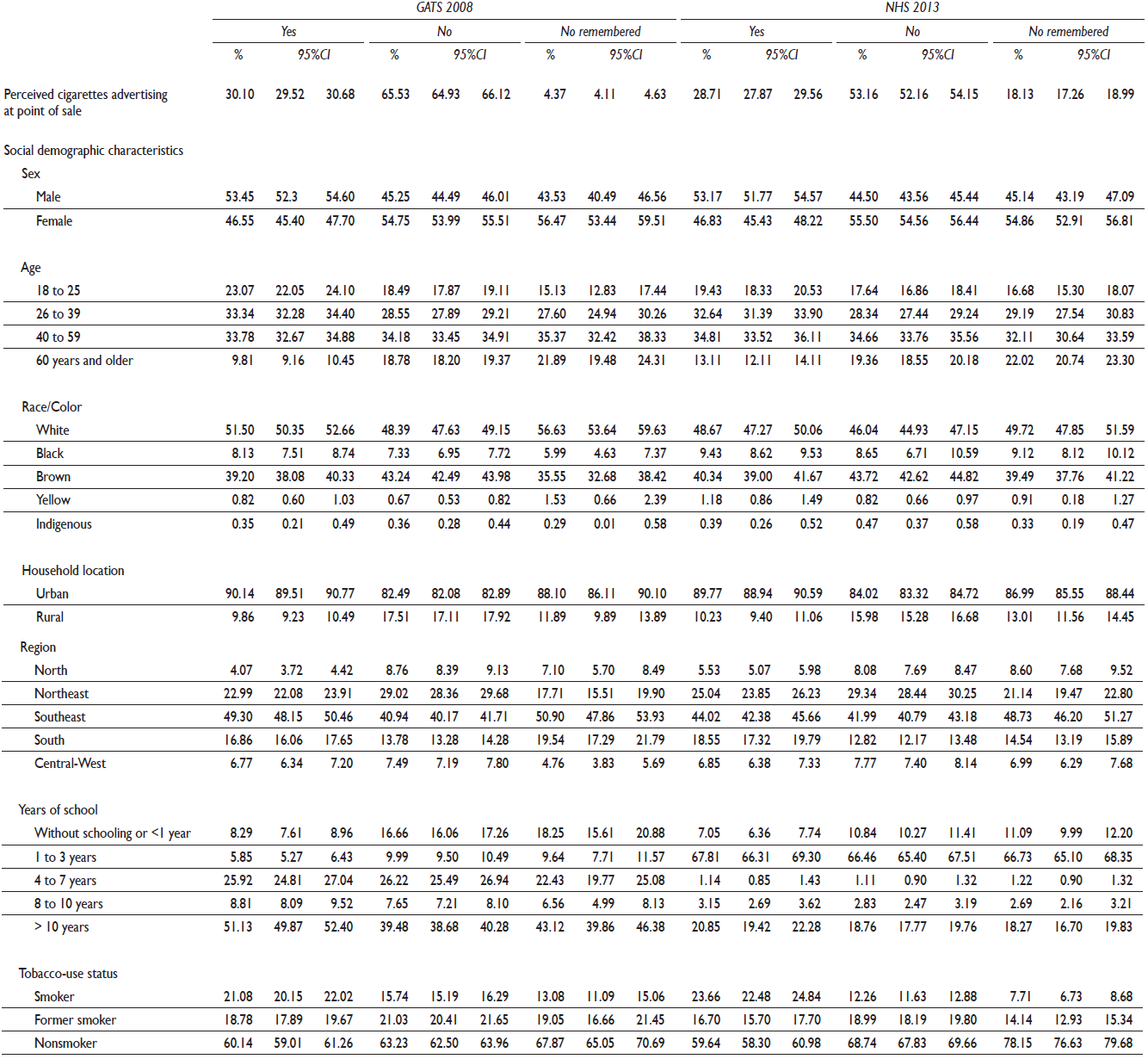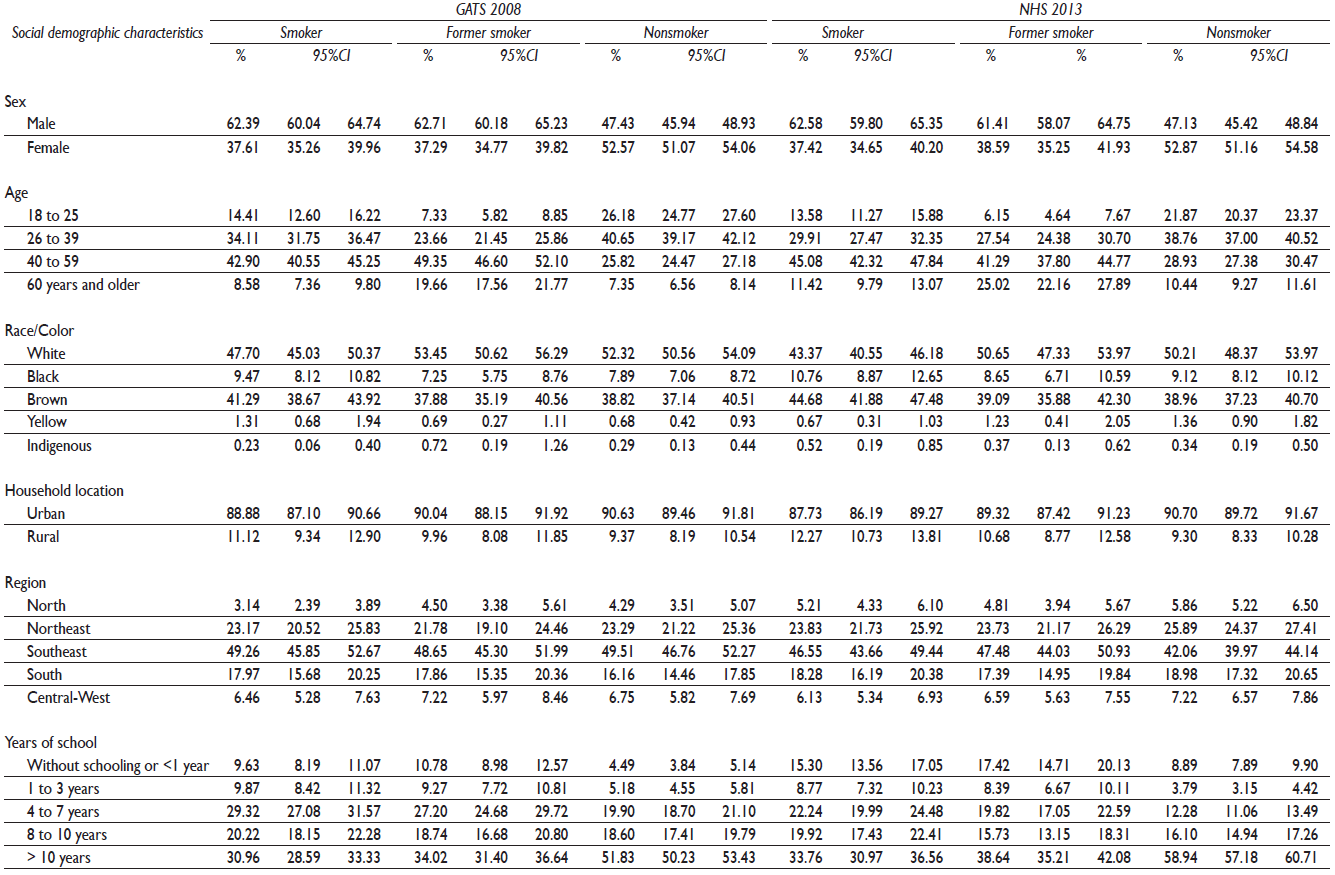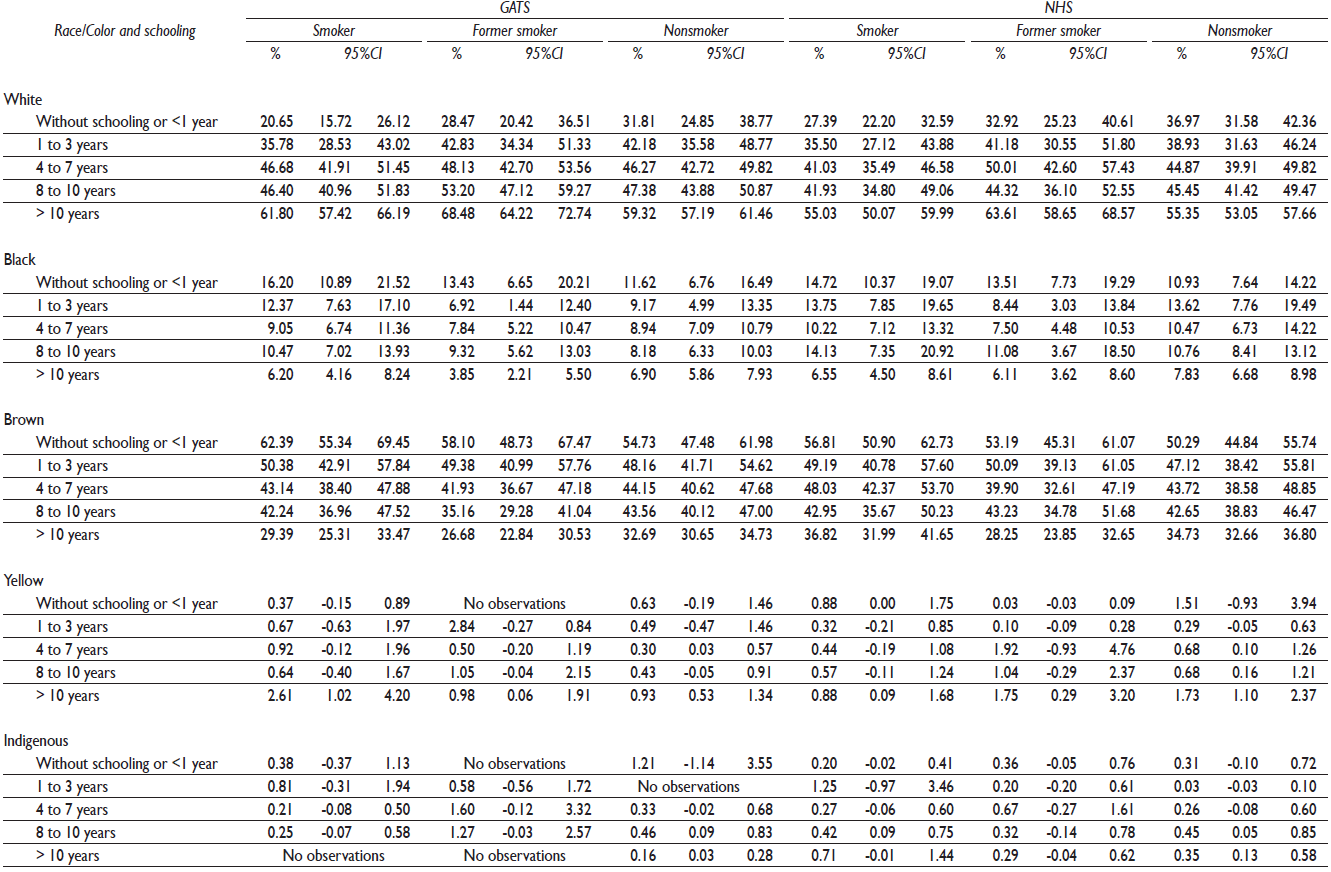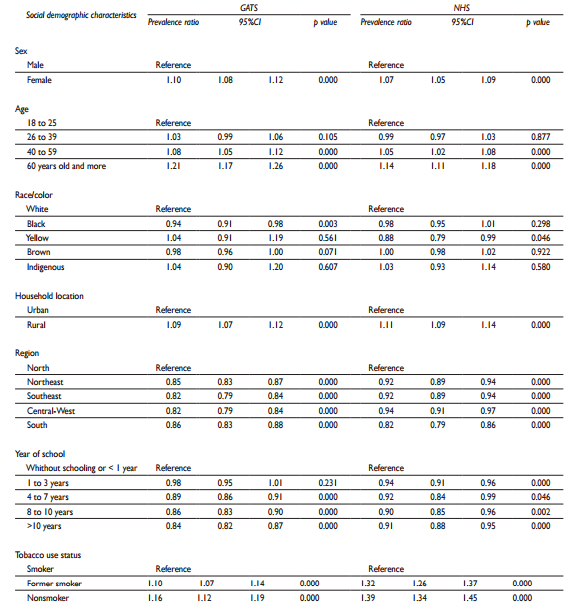Introduction
The advertising of tobacco products has always been an important and strategic tool explored by the tobacco industry to gain new users and keep current ones.1,2,3,4 Both, direct and indirect advertisement, are one of the biggest influences on starting to smoke, especially among children and youth.5,6 It is undeniable the impact that advertising has on the behavior of consumers, who are the target of a large amount of inaccurate information on the products being offered.7
A significant reason why there is a control over the advertising of tobacco products is to prevent the consumers of having poor or false information from a scientific point of view to prevent bias towards the willingness to acquire a particular product. Instead of being informative and enlightening, tobacco advertisement has always sought to associate the consumption of cigarettes to a pleasant ambiance or sports images, success, refinement, sociability and good health that portrays tobacco use as a norm.5,7
The WHO Framework Convention on Tobacco Control (FCTC), an evidence-based treaty, came into force on February 27 of 2005. It developed a response to the globalization of tobacco epidemic. The article 13 of the FCTC recognizes the banning of all forms of advertising, promotion or sponsorship of tobacco products, is an important measure that would reduce the consumption of tobacco products.8 Long before the FCTC, Brazil had already adopted laws to limit the advertising of tobacco products.9 Law number 929410 published in 1996 applied time restrictions on the broadcast of tobacco product advertisements on television and radio. That law was later modified by law 10167 in 2000 which restricted the commercial advertising of tobacco products to posters and banners that could be placed only at point of sales.11
In 2003, the Brazilian Agency of Sanitary Surveillance - ANVISA, which regulates the tobacco products, issued a resolution that established the definition on advertising at point of sale and banned selling and promotion of tobacco products on the internet.12 In the same year, another resolution regulating printing of health warning phrases and images on the advertising materials was established.13
Brazil ratified the FCTC in November of 2005, implementing more strict measures to reduce the demand and consumption of tobacco products. These measures included an increase on tax and price of tobacco products, implementing smoke-free environments and a size increase of health warnings on packets of tobacco products. The law 12546, published in 2011, banned all forms of advertising of tobacco products, only allowing the product display at point of sale.14 However, to enter into force effectively, it would depend on the publication of a regulatory decree, that occurred in May 2014 but started having legal effect in December of that year.15
Due to the increase restriction of advertisement on media, tobacco companies have aggressively pursued point of sale advertising in order to keep tobacco attractive, especially for young people. Point of sale is any commercial place which enables the display of products for sale, such as markets, convenience stores, bars and bakeries etc.16 The Tobacco Industry also uses point of sale as a lab to make marketing research and collect information on potential and current consumers and marketing leadership.3
Several studies suggest that point of sale advertising affected smoking cessation and stimulated impulse purchasing among smokers.17,18.19,20 The exposure to tobacco brands imagery stimulated physical craving and resurrected the emotional ties that they had with “their” brand among lapsed quitters and former smokers.21 Cigarette pack displays may also function to undermine quitting intention among established smokers. According to a study held in Australia, young smokers were more likely to notice cigarette displays and tended to more likely purchase on impulse.22
Using the data provided by the Global Adult Tobacco Survey in 2008 and the National Health Survey (NHS) in 2013, the aim of this study is to describe the Brazilian adult population that notices advertising of cigarettes at point of sale according to tobacco-use status and socio-demographic characteristics such as gender, age, race/color, region, household location and schooling and compare the findings of the two national surveys to identify possible differences between these groups.
Materials and methods
This is a comparative study between two population-based surveys conducted in Brazil during two different periods: The Global Adult Tobacco Survey (GATS) also known in Brazil as PETab and the National Health Survey (NHS); regarding the perception of point of sales advertising among adults (>18 years old). The GATS was performed in 2008 and its sampling plan was a multi-stage stratified sample with 51 011 households. The primary units were municipalities, the secondary were number of households in each municipality of sample. Private households or housing units in collective households were selected in the third stage. In the last stage, one resident 15 years old or older was selected from each household. There were total of 39 425 completed interviews.
In 2013, during the National Health Survey (NHS), specific GATS questions (Tobacco Questions for Surveys: TQS)23 were incorporated in this broad national survey. The target population of NHS was adults (18 years or older) living in private households throughout Brazil. A multi-stage stratified sample with three stages was conducted. The primary units were census tracts or set of sectors, the secondary units were households, and tertiary-stage units were residents aged 18 or older. In this sampling, 81 167 households were estimated, however with 60 202 individuals interviewed.
Both surveys have nationally representative samplings. Expansion factors or sample weighting were defined for the population estimates in each survey. Details about the methodology, sampling plan, and calculation of the expansion factors can be obtained through previous publications.24,25
To allow comparability between these two surveys, the first selection made on GATS was to identify the individuals aged 18 years and above. A second selection was made to identify the individuals which responded “yes” to the question “V7298” - “In the last 30 days, have you noticed any advertisements or signs promoting cigarettes: In cigarettes sales points?” Additionally, on NHS, adults which answered “yes” to this question “p069” - “In the last 30 days, have you saw any advertisements of cigarettes in point of sale?” were selected to the present study.
We classified our sample considering tobacco-use status: smokers, former smokers and nonsmokers. The smoker group is who currently smokes daily or less than daily; the former smoker group is who in the past had smoked any tobacco product daily or less than daily; finally, the nonsmokers are who never smoked.
Data analysis was performed using the statistical software Stata 11.0. We calculated the proportions of adults that perceived cigarette advertising at point of sale considering tobacco-use status, with their respective confidence intervals of 95% (95%CI). Proportions were estimated based on social demographic variables, such as sex, age (18 to 25; 26 to 39; 40 to 59; 60 and older), race/color (white, black, brown, yellow - Asian and indigenous - native Brazilian). Household location (urban, rural), schooling (Without schooling or <1 year; 1 to 3 years; 4 to 7 years; 8 to 10 years; > 10 years) and Brazilian regions (North, Northeast, Central-West, Southeast and South). The race/color “brown”, or “pardo” in Portuguese, permits individuals to self-identify as a mixed race, “black” referring basically to those who self-identity as being predominantly African ancestry; and “yellow” refers to those with Asian background, these predominantly being Japanese ancestry. Confidence Intervals of 95% were used to determine significant difference between groups. Multivariate Poisson regression was performed to verify association between social demographic characteristics and tobacco-use status and adults that noticed cigarettes advertising in point of sale (outcome).
The implementing agency responsible for both surveys was the Brazilian National Institute of Geography and Statistics (IBGE) that complies with the norms proposed by the United Nation Statistic Commission. For this reason, it is exempt from submitting all its surveys to the National Ethics Committee and its not obliged to obtain informed consent from the individuals interviewed.24
Results
Brazilians adults that noticed advertising of cigarettes at point of sale represented 30.1% on GATS and 28.71% on NHS. The highest proportions of adults that noticed advertising of cigarettes at point of sale, in both surveys, were found among male, group of 26 to 39 and 40-59 years old, white people, who live in the urban areas and nonsmoker. On GATS, who had >10 years of schooling presented the highest proportion of adults that noticed advertising of cigarettes in point of sale; however, on NHS, this group was composed of individuals with 1 to 3 years of schooling (table I).
Table I Percentage and 95% Confidence Interval (95% CI) of adults (18 years old and more) in Brazil by perceiving or not cigarettes advertising at point of sale and social-demographic characteristics and tobacco-use status. GATS (2008) and NHS (2013)

In both surveys, men, smokers or former smokers perceived cigarette advertising at point of sale more frequently than women with the same tobacco-use status (table II). However, among nonsmokers, women had the highest proportion of those who saw advertising with a significant difference [GATS 52.57% (95%CI 51.07-54.06) and NHS 52.87% (95%CI 51.16-54.58)].
Regarding age, both surveys showed similar results. Considering smokers and former smokers, the cigarettes advertising was perceived more frequently by the group aged 40 to 59 years, followed by the group of 26 to 39 years old. Among nonsmokers, the age group of 25 to 39 years presented the highest percentage of individuals that saw the advertising. Specifically in the age group of 18 to 25 year old, nonsmokers presented the highest percentage in both surveys. In the elderly population, the group of former smokers had the highest percentage of people who saw cigarette the advertising [GATS 19.66% (95%CI 17.56- 21.77) and NHS 25.02% (95%CI 22.1-27.89)] when compared with the smokers [GATS 8.58% (95%CI 7.36-9.80) and NHS 11.42% (95%CI 9.79-13.07)] and nonsmokers [GATS 7.35% (95%CI 6.56-8.14) and NHS 10.44% (95%CI 9.27-11.61)] (table II).
Table II Percentage and 95% Confidence Interval (95% CI) of adults (18 years old and more) in Brazil that perceived cigarettes advertising at point of sale by tobacco-use status and social-demographic characteristics. GATS (2008) and NHS (2013)

Regardless of tobacco use status and race/color categories, the results presented in both surveys demonstrated that the advertisements of cigarettes at point of sales were seen more frequently by the white and brown populations. Both the indigenous (native Brazilian) and yellow (Asian) population presented the lowest percentages (less than 1.5%).
The percentage of adults in both surveys that saw the advertising of cigarettes was higher among people who live in the urban areas for any tobacco-use status. The southeast region of Brazil had the highest percentage of people who saw the cigarette advertising and the north region presented the lowest for all categories of tobacco-use status; however, the data from NHS indicated a significant increase among smokers and nonsmokers in this region (table II).
When considering years of schooling, among any tobacco use status, the highest percentage of people that observed the advertising of cigarettes at point of sale was the group with more than > 10 years of schooling and nonsmokers. They presented the highest values in both survey.
Despite that the data from GATS had showed that the group without schooling or < 1 year of schooling presented the lowest percentages among smokers [9.63% (95%CI 8.19-11.07)] and nonsmokers [4.49% (95%CI 3.84-5.14)], particularly in this group, the data from NHS showed a significant rise [(smokers: 15.30%, (95%CI: 13.56-17.05), nonsmokers: 8.89% (95%CI: 7.89-9.90) and former smoker: 17.42% (95%CI: 13.56-17.05), respectively)]. In NHS for all tobacco use status the lowest percentages of people who saw the cigarettes advertising where concentrated among respondents with 1 to 3 years of schooling (table II).
Table III shows the data for each tobacco-use status by race/color and schooling. The purpose of this cross-checking was to evaluate if there are inequalities regarding the perception of cigarettes advertising at point of sale and verify if there is confounding effect between race/color and schooling. Comparing white, brown and black adults, the race/color black presents the fewer percentages for all schooling categories and all tobacco smoke-use status in both surveys. Excepted for those without schooling or <1 year, they haven’t showed difference between race/color white on GATS. The small number of observations for the race/color yellow and indigenous categories limited comparisons among them.
Table III Percentage and 95% Confidence Interval (95%CI) of adults (18 years old and more) in Brazil that perceived cigarettes advertising at point of sale considering race/color and schooling by tobacco-use status. GATS (2008) and NHS (2013)

Analyzing each schooling category in both surveys for any tobacco-use status a statistical difference was observed in a reverse way between white and brown in two categories (“Without schooling or <1 year” and >10 years). It was found that brown individuals among those with no schooling or <1 year of schooling viewed tobacco advertising more frequently. Between those who have had over 10 years of study, the highest proportion of people who saw the cigarette advertising was observed among whites.
In both surveys, the prevalence of perceiving cigarettes advertising at point of sale was positively associated with female, age group of 40 to 59 years old and 60 years and older, rural household, former smoker. Thus, the group of adults that reported not noticing cigarettes advertising at point of sale was men, young, black and yellow individuals (just NHS), urban households, living in all regions of the country except the north region, with one or more years of schooling and smokers (table IV).
Discussion
According to WHO, tobacco companies spend tens of billions of dollars each year on tobacco advertising, promotion and sponsorship. Despite being designed to have a broad appeal to consumers in all demographic groups and especially among current smokers, special efforts are made to persuade nonsmokers to start. One third of youth experimentation with tobacco occurs as a result of exposure to tobacco advertising, promotion and sponsorship.26
For more than a century, tobacco companies have been developing sophisticated marketing strategies for their product packages, with the objective of reinforcing tobacco initiation among young people as well as maintaining addiction and consumption among regular users.27 This strategy has been more and more used, mainly due to the world trend of banning tobacco product advertisement.28
In Brazil, despite having since 2011 a law that bans all kind of advertising, this law just came into force effectively national wide in December 2014. It still allows the display of products in retail outlets. The law doesn’t bring definition regarding size, location and display’s placement within the retail outlet. The result of this lack of definitions and also inspection for compliance with the law is the continuous use of cigarettes advertising at point of sales that do not bring warning information.29
There are different strategies to display the products in order to capture the attention of consumers: the use of highly produced displays, stickers, banners, neon signs, among others.29 The packaging of tobacco products is an important marketing tool, linked to quality or influencing the purchasing decision.16
The results presented in this article showed that, between men and women, nonsmoker women had noticed advertising of cigarettes at point of sale more frequently than nonsmoker men. According to disclosed documents from the tobacco industry, tobacco corporations always have invested in strategies targeting women given that they live longer than men, they seem to be less influenced by anti-smoking campaign, as well as have increased spending power and are adopting more dominant roles in the society.30
Although the tobacco industry does not publicly assume that young people are its most important target population, several studies have showed that many strategies related to packaging, additives and, of course, advertising, promotion and sponsorship actions are directed to this audience and they have been used often.31,32,33
“If our company is to survive and prosper, over the long term we must get our share of the youth market […] Thus we need new brands designed to be particularly attractive to the young smoker, while ideally at the same time appealing to all smokers […] Perhaps these questions may be best approached by consideration of factors influencing pre-smokers to try smoking, learn to smoke, and become confirmed smokers” (R.J. Reynolds, 1973).33
Regarding to advertising at point of sale and marketing, according studies conducted by Henriksen and colleagues, they are more prevalent in stores where adolescents shop regularly.27,34,35 This paper did not allow to understand the perception of adolescents to advertising of cigarettes at point of sale; however, among nonsmokers the individuals that more frequently noticed advertising of cigarettes at point of sale were young adults (18 to 25 and 26 to 39 years old). It indicates accordance to the tobacco industry’s strategies to address this advertising to younger population.
Considering smokers and former smokers, the age group that noticed tobacco advertising more frequently was 40 to 59 years old. Several studies conducted in Brazil related to tobacco cessation indicated that the average age of people that seeks treatment to stop smoking is 40 years and older.36,37,38 Studies conducted in Australia and New Zealand demonstrated that cigarette advertising or the presence of cigarette displays in stores have an effect over impulsive, or non-planned purchase of cigarettes which jeopardize cessation attempts.22,39,40
It is also important to highlight that among the elderly the cigarette advertising was noticed more frequently by former smokers. The effects of smoking on smoker’s health become more evident as a result of aging.41 The NHS findings showed that the proportion of former smokers increases with age: among people aged 60 years and older, 31.1% stopped smoking against 5.6% in the group aged 18 to 24 years.25 Based on this result, one hypothesis that could be raised is that out of this group, the perception of cigarette advertising can be a result of linking between the former current use of cigarette and the effects that this product might have caused to the individual. However, further qualitative studies would be necessary to prove this assertion.
Both GATS and NHS showed that the highest prevalence rates of smoking are on the rural area24,25 even though as for the perception of cigarettes advertising, it was more frequent for people from the urban areas. It would be possible to infer that in the urban areas there are higher concentrations of commercial outlets that need to promote their products more outwardly. Further studies would be required to understand these findings.
According to the data from the two surveys, the south region presents the highest prevalence rates of smoking, followed by the southeast. Yet on the issue of this analysis, the population from the southeast and the northeast regions of Brazil noticed more frequently the cigarettes advertising at point of sale with no difference among tobacco use status. In regards to the significant increase of people that noticed cigarette advertising at point of sale in the North region comparing to GATS, other studies are needed to explain this occurrence.
There are studies that correlate smoking and poverty.42,43 Although the trend in the prevalence of smoking in Brazil shows a general decreasing,44,45 the reduction ratio is less in the low-income groups.46,47 For this paper, schooling was considered a proxy for socioeconomic status. In an isolated manner on both surveys the higher schooling the greater the perception of advertising of cigarettes at point of sale, especially among nonsmokers. As the tobacco industry’s strategy is to always seek new customers, it may be considered that this result is a consequence of an intentional direction of advertisements in retail outlets. Higher income means increased purchasing potential.
On the other hand, it is important to note that among individuals without schooling or less than one year of schooling, when we compare the data from the two surveys, there was a significant increase for all tobacco use status. This same behavior was observed analyzing race/color and schooling together. The greatest percentages of noticing advertising were between black and brown respondents in the group with the lowest schooling, regardless of tobacco use status.
The measure of raising taxes and prices of cigarettes is proved to impact on the consumption of this product, especially in consumers with low-income status.48 However, a study conducted by the National Cancer Institute (INCA) in Brazil, that also compared data from these two surveys, revealed that among the remaining smokers there was an increase in the proportion of those who consume cigarettes from illegal sources (increased from 15.8% in 2008 to 29.7% in 2013).49 This effect might help to explain the results found in this paper. The illegal products may have been exposed in retail displays and those ads may be considered advertising by the respondents or even, the tobacco industry keep investing on retail outlets in low income areas, not only to win new consumers, but also to keep the old ones.
Conclusion
Although the ban of any kind of tobacco advertising is a measure that should be implemented by all Parties of the WHO FCTC, in many of them, including Brazil, even after the ratification of the treaty, the permission to have cigarette advertising at point of sales or at least the display of cigarettes packages remains. Through the results presented on this paper, it is possible to conclude that in Brazil, despite being restricted to point of sales, the advertising of cigarettes was perceived more frequently by women and young adults. These findings are useful to support the decision maker when establishing specific actions for the target population.
In order to advance our knowledge, others studies can also generate more arguments whether a measure that completely bans tobacco advertising and the display of tobacco products would be more effective to protect the population from tobacco consumption, especially the vulnerable groups.











 nueva página del texto (beta)
nueva página del texto (beta)



